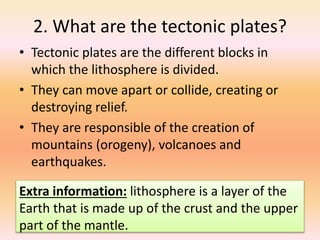Unit 2: The formation of the Earth's relief
- 1. Unit 2: The formation of the Earth’s Relief In this unit we are going to study the formation of the relief of the Earth.
- 2. The Earth’s Relief Process of Formation Process of Erosion Internal Forces External Forces • Continental Drift • Tectonic Plates • Orogeny • Volcanoes • Earthquakes • Erosion, transport and deposition • Water (rainfall, rivers, seas…) • Wind • Plants • Human Beings
- 3. 1. What is the Continental Drift? • Continental drift (deriva continental) is a theory that says that the continents have been moving (or drifting) all along the geological eras. Click on the image Extra information: this theory was developed by Alfred Wegener in 1912.
- 5. 2. What are the tectonic plates? • Tectonic plates are the different blocks in which the lithosphere is divided. • They can move apart or collide, creating or destroying relief. • They are responsible of the creation of mountains (orogeny), volcanoes and earthquakes. Extra information: lithosphere is a layer of the Earth that is made up of the crust and the upper part of the mantle.
- 6. Extra information: Why do the Tectonic plates move? There are many theories but they are not totally clear and confirmed yet. One says that it happens because of the convective movement of the mantle (which is hot and liquid). Other theory says that it happens because of the attraction forces (tidal forces) of the Sun and the Moon. And we can not forget that the Earth is spinning at a speed of 220 km/sec approx., that the lithosphere is divided in many parts called tectonic plates and that this tectonic plates are floating on the mantle.
- 10. 3. Cross-section of the Earth’s relief
- 11. Rift of Iceland
- 12. Mariana Trench (11.034 m of depth)
- 13. What are the parts of a volcano? 1. Gases 2. Rocks 3. Lava 4. Crater 5. Molten magma 6. Side Vent 3. Cone
- 14. Mount Etna
- 15. El Volcán de Sta Margarita es uno de los más importantes del sector, de 682 metros de altitud y su boca tiene un perímetro de 2.000 metros. En el centro del llano formado por el cráter se encuentra la Iglesia de Santa Margarita, de origen románico. Su última erupción data de hace 11.000 años
- 17. 4. Landforms • Study the landforms of your textbook
- 18. External Forces 5. What are the external forces? The external forces are external agents that modify the relief of the Earth through the process of erosion, transport and deposition. (Erosión, transporte y sedimentación).
- 19. What would you write in each box? Erosion Transport Deposition
- 20. 6. What external forces modify the relief? The external forces or erosive agents are: • Temperature • Wind • Rainfall • Rivers • Sea • Glaciers • Groundwater (aguas subterráneas) • Living things (plants, animals and human beings)
- 21. What external force eroded this rock? Salar de Uyuni, Bolivia
- 22. Balanced Rock, Garden of the Gods Colorado, USA
- 23. Boulders - South Island - New Zealand
- 24. Bryce Canyon National Park - Utah, USA
- 25. White Cliffs of Dover
- 26. THE CATHEDRALS´ BEACH (Lugo)
- 28. The Giant's Causeway - Northern Ireland, UK
- 35. Parque Nacional de Ordesa, Aragón
- 36. Las Médulas



































